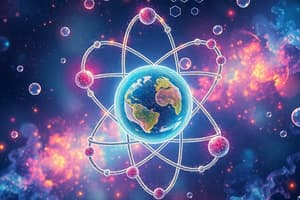Podcast
Questions and Answers
Which property is not typically associated with metals?
Which property is not typically associated with metals?
- Malleability and ductility
- Good thermal conductivity
- Brittleness (correct)
- High melting and boiling points
Which type of element has a dull appearance and is a poor conductor of electricity?
Which type of element has a dull appearance and is a poor conductor of electricity?
- Metals
- Non-metals (correct)
- Semi-metals
- All of the above
Which subatomic particle has a relative mass of 1 and a positive electric charge?
Which subatomic particle has a relative mass of 1 and a positive electric charge?
- Proton (correct)
- Neutron
- Electron
- None of the above
Which property is typically associated with semi-metals?
Which property is typically associated with semi-metals?
What is the purpose of the statement 'An atom is electrically neutral'?
What is the purpose of the statement 'An atom is electrically neutral'?
Which subatomic particle has a negligible relative mass and a negative electric charge?
Which subatomic particle has a negligible relative mass and a negative electric charge?
What is the atomic number of lithium (Li)?
What is the atomic number of lithium (Li)?
Which element has the atomic number 20?
Which element has the atomic number 20?
What is the sum of the first four ionization energies for beryllium (Be)?
What is the sum of the first four ionization energies for beryllium (Be)?
Which group does fluorine (F) belong to?
Which group does fluorine (F) belong to?
What is the electronic configuration of potassium (K)?
What is the electronic configuration of potassium (K)?
What is the relationship between the atomic number (Z) and the number of protons in an atom?
What is the relationship between the atomic number (Z) and the number of protons in an atom?
What is the relationship between the mass number (A) and the number of protons and neutrons in an atom?
What is the relationship between the mass number (A) and the number of protons and neutrons in an atom?
What is the relationship between the atomic number (Z) and the number of electrons in a neutral atom?
What is the relationship between the atomic number (Z) and the number of electrons in a neutral atom?
What is the definition of isotopes?
What is the definition of isotopes?
How is the relative atomic mass of an element calculated?
How is the relative atomic mass of an element calculated?
What is the relationship between the relative isotopic mass and the mass number of an isotope?
What is the relationship between the relative isotopic mass and the mass number of an isotope?
Flashcards are hidden until you start studying
Study Notes
The Periodic Table
- The modern periodic table is a tabular arrangement of elements, organized by their atomic number (number of protons), electron configuration, and recurring chemical properties.
- Elements can be classified into metals, non-metals, and metalloids.
Atomic Structure
- An atom is the smallest part of an element that has the chemical properties of that element.
- Atoms are made up of three subatomic particles: protons, neutrons, and electrons.
- Protons have a relative mass of 1 and a positive charge, and are located inside the nucleus.
- Neutrons have a relative mass of 1 and no charge, and are located inside the nucleus.
- Electrons have a negligible mass and a negative charge, and move around the nucleus.
- An atom is electrically neutral because the number of protons is equal to the number of electrons.
Atomic Number and Mass Number
- Atomic number (Z) of an atom is equal to the number of protons in the atom.
- Mass number (A) of an atom is equal to the number of protons + number of neutrons in the atom.
- The atomic number (Z) and mass number (A) of an atom are usually shown in a full atomic symbol as:
A Z X
Isotopes, Relative Isotopic Mass, and Relative Atomic Mass
- Isotopes are different atoms of the same element, with the same number of protons but different numbers of neutrons.
- The relative isotopic mass of an isotope is roughly equal to its mass number.
- The relative atomic mass of an element is the weighted average of the relative isotopic masses of all the naturally occurring isotopes of that element on the 12C = 12.00 scale.
Properties of Metals and Non-Metals
- Metals are typically solids (except mercury), have a shiny appearance, high melting and boiling points, and are good conductors of heat and electricity.
- Non-metals are typically gases or solids, have a dull appearance, low melting and boiling points, and are poor conductors of heat and electricity.
- Metalloids (semi-metals) have properties intermediate between metals and non-metals, examples include boron and silicon.
Studying That Suits You
Use AI to generate personalized quizzes and flashcards to suit your learning preferences.





